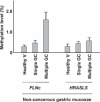Aberrant DNA methylation in contrast with mutations
- PMID: 19958364
- PMCID: PMC11159270
- DOI: 10.1111/j.1349-7006.2009.01434.x
Aberrant DNA methylation in contrast with mutations
Abstract
Aberrant DNA methylation is known as an important cause of human cancers, along with mutations. Although aberrant methylation was initially speculated to be similar to mutations, it is now recognized that methylation is quite unlike mutations. Whereas the number of mutations in individual cancer cells is estimated to be approximately 80, that of aberrant methylation of promoter CpG islands reaches several hundred to 1000. Although mutations of a specific gene are very few in non-cancerous (thus polyclonal) tissues (usually at 1 x 10(-5)/cell), aberrant methylation of a specific gene can be present up to several 10% of cells. Mutagenic chemicals and radiation are well-known inducers of mutations, whereas chronic inflammation is deeply involved in methylation induction. Although mutations are induced in mostly random genes, methylation is induced in specific genes depending on tissues and inducers. Methylation is potentially reversible, unlike mutations. These characteristics of methylation are opening up new fields of application and research.
Figures




References
-
- Esteller M. Epigenetics in cancer. N Engl J Med 2008; 358: 1148–59. - PubMed
-
- Ushijima T. Detection and interpretation of altered methylation patterns in cancer cells. Nat Rev Cancer 2005; 5: 223–31. - PubMed
-
- Feinberg AP, Vogelstein B. Hypomethylation distinguishes genes of some human cancers from their normal counterparts. Nature 1983; 301: 89–92. - PubMed
-
- Feinberg AP, Tycko B. The history of cancer epigenetics. Nat Rev Cancer 2004; 4: 143–53. - PubMed
Publication types
MeSH terms
LinkOut - more resources
Full Text Sources

